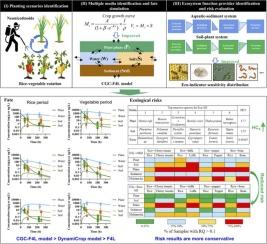结合作物生长水平逸度模型和生态指标敏感性评估热带稻菜轮作中新烟碱命运和生态风险的新框架
IF 11.3
1区 环境科学与生态学
Q1 ENGINEERING, ENVIRONMENTAL
引用次数: 0
摘要
由于干湿交替条件、高新烟碱(NEO)投入和复杂的多媒体运输,热带稻-蔬菜轮作面临着不断升级的农药管理挑战,但现有模型忽略了作物生长动态和轮作特有的风险。为解决这一问题,我们结合作物连续生长曲线级逸度模型(CGC-L4F)和生态指标敏感性分布(Eco-SD)构建了创新的农药评价框架,用于预测热带稻菜轮作系统中新生物的命运和生态风险。将该框架应用于4种水稻-蔬菜轮作系统中吡虫啉、啶虫啉及其共同转化产物6-氯烟酸(6-CNA),结果表明,在蔬菜-水稻生育期,媒介中NEOs和6-CNA浓度下降了1.13-5.67倍,主要归因于NEOs的投入、作物轮作和植物生长。作物轮作模式和作物量加剧了NEO在多媒体内部和多媒体之间分布和运输的异质性,容易从土壤中积累到水和植物中。CGC-L4F模型持续模拟时间变化,具有很强的统计拟合(R2 > 0.7)和可接受的偏差(±1个log单位)。Eco-SD方法结合了生态系统服务提供商,成功地识别了特定媒体和季节差异的风险模式。该框架侧重于动态作物生长和生态系统服务,是第一个量化近地天体在轮作系统中的时间命运和风险的框架,表明尽管存在固有的不确定性,但综合建模提供了强大的预测能力。本文章由计算机程序翻译,如有差异,请以英文原文为准。

A new framework integrating crop growth–level IV fugacity model and eco-indicator sensitivity to assess neonicotinoid fate and ecological risk in tropical rice–vegetable rotations
Tropical rice–vegetable rotations face escalating pesticide management challenges due to alternating wet–dry conditions, high neonicotinoid (NEO) input, and complex multimedia transport, yet existing models overlook dynamic crop growth and rotation-specific risks. To address this, we constructed an innovative pesticide assessment framework by combining continuous crop growth curve–level IV fugacity model (CGC-L4F) and eco-indicator sensitivity distribution (Eco-SD) to predict the fate and ecological risks of NEOs in multimedia of tropical rice–vegetable rotation systems. Applying the framework to imidacloprid, acetamiprid, and their shared transformation product 6-chloronicotinic acid (6-CNA) in four field-applied rice–vegetable rotation systems revealed that NEOs and 6-CNA concentrations in multimedia decreased by 1.13–5.67 times from vegetable to rice growth period, primarily attributed to NEOs input, crop rotation, and plant growth. Crop rotation pattern and crop volume exacerbated NEO heterogeneity of distribution and transport within and between multimedia, causing easy accumulation in water and plants from soil. The CGC-L4F model consistently simulated temporal variations with strong statistical fit (R2 > 0.7) and acceptable deviation (±1 log unit). The Eco-SD approach, incorporating ecosystem service providers, successfully identified media-specific and seasonally differentiated risk patterns. This framework, focusing on dynamic crop growth and ecosystem services, is the first to quantify NEOs’ temporal fate and risks in rotation systems, demonstrating that integrated modeling offers robust predictive capacity despite inherent uncertainties.
求助全文
通过发布文献求助,成功后即可免费获取论文全文。
去求助
来源期刊

Journal of Hazardous Materials
工程技术-工程:环境
CiteScore
25.40
自引率
5.90%
发文量
3059
审稿时长
58 days
期刊介绍:
The Journal of Hazardous Materials serves as a global platform for promoting cutting-edge research in the field of Environmental Science and Engineering. Our publication features a wide range of articles, including full-length research papers, review articles, and perspectives, with the aim of enhancing our understanding of the dangers and risks associated with various materials concerning public health and the environment. It is important to note that the term "environmental contaminants" refers specifically to substances that pose hazardous effects through contamination, while excluding those that do not have such impacts on the environment or human health. Moreover, we emphasize the distinction between wastes and hazardous materials in order to provide further clarity on the scope of the journal. We have a keen interest in exploring specific compounds and microbial agents that have adverse effects on the environment.
 求助内容:
求助内容: 应助结果提醒方式:
应助结果提醒方式:


